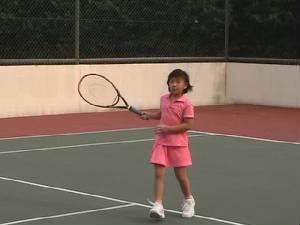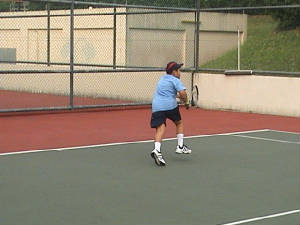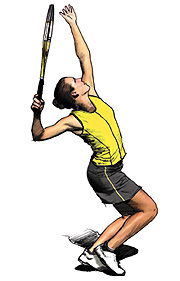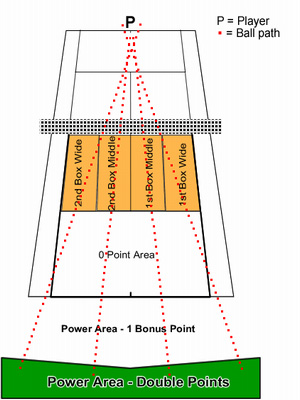|
The first step of knowing what result you want is critical to maintaining
control of the learning process where it belongs – with you. After reading an article or watching some people serve
with the new method, don’t jump to the conclusion that this new way is necessarily “right” for you. Just
let yourself observe whatever it finds interesting, and certain things will stand out or come to the foreground of your attention
spontaneously. Allow yourself to focus on elements that in its intelligence it might be ready to experiment with.
I cite this instruction for two reasons: first, to show that gospels change
and they are changed by people who had the courage to experiment outside the boundaries of the existing doctrine and trust
in their own learning process. The second reason is to suggest that prescribed way of making a change itself needs to change.
This may way work for touring pros but does that mean it best for the weekend players?

1.
Backswing:
* Exactly where is the head of your racket at the back of your swing?
* Where is the ball when you initiate your backswing?
* What happens with the face of the racket during the backswing?
2. Impact:
* Can you feel where the ball is meeting the racket at impact?
* How is your weight distributed?
* What is the angle of the racket face?
* To what extend can you feel the kind and amount being imparted to the
ball?
* How solid does the shot feel or how much vibration is sent to your arm?
* How far in front of or behind you is the ball at impact?
3. Follow-through:
* Where does your racket finish?
* In what direction?
* What has happened to the face of the racket since impact?
* Is there any hesitancy or resistance experienced during the follow-through?

4. Footwork:
* How is your weight distributed during preparation and at impact?
* What happens to your balance during the shot?
* How many steps did you take to get to the ball?
* What size are the steps?
* What kinds of sounds do your feet make on the courts as you move?
* When the ball approaches you, do you retreat, advance or hold your ground?
* From how solid a base are you when hitting the ball?

Your coach can be helpful in pointing out the best focus of attention for
your particular serve at its current state of development. As long as you take his guidance as an opportunity to explore your
own experience, you really cannot help but learn in a natural and effective manner.
Besides the fact that we all have to learn as individuals, it is also obvious
that there is no one best way to serve for everyone.
If there were, why do so many of the best servers in tennis today serve
so differently? Each may have learned things from others, but each of them evolved over time a way of serving that suited
his own body, skill level, personality traits – in short, himself. And their process is still evolving. And in spite
of all the credit they might give to different players or coaches for helping them find their serves, their primary development
was directed from within themselves by that simple process of what feels good and what works for each individual.
As with many of the other strokes in tennis, the orthodox approach to the
serve is under challenge by pros who seem to be breaking out of this mold. When I learned to serve some thirty years ago,
my friend, a touring pro, Roscoe Tanner, one of the fastest server in the field, taught the approved method of the time. To
get the arms moving in the correct direction and rhythm, we chanted the mantra, “down together, up together, hit”.
What this meant was that both the tossing arm were brought down at the same time. Then as the tossing arm was raised to toss
the ball, the hitting arm was also raised and dropped down the back like in the preparation of throwing a spear into the air.
Then depending on how high the ball was tossed, the hitting arm would surge forward to strike the ball so that it would be
fully extended at impact, and then follow through past the feet.

The best serves in today’s game do not follow this down-together-up-together
motion. So from the point of view of the “right way” to serve, all these great players are doing it “wrong.”
To learn to serve like these pros, the player is instructed to: “As
the tossing arm rises, drop the hitting arm back and down”
The old “up-together” technique, which may seem more rhythmic,
actually works against creating power for some players, because it forces the hitting arm to pause at the top of the backswing,
destroying the build-up momentum to that point.
Most import of all in the “palm-down” position: i.e., the hitting-hand
palm is facing the ground at the moment the ball is released … This is necessary to achieve the “lasso effect”
of a good serve, in which the racket is then quickly raised above the head and circle down around the back before snapping
up to strike the ball.

The Serve
Compared with the other strokes of tennis, the serve is the most complicated. Both arms are involved
in the stroke, and your hitting arm is making simultaneous movements of shoulder, elbow and wrist. The movements of the serve
are much complicated to be mastered by memorizing instructions for each element of the stroke. But it is not so difficult
if you do the learning by focusing attention on the different elements of the strokes as well as the stroke as a whole.
Some places to focus attention on the Serve
In general, there are some specific places where it can help to focus
your attention for practicing your serve. Remember the fundamental goal is still the same, over the net and into the court
with power, accuracy and consistency. Here are just a few variables to consider.

Rhythm
* Observe the rhythm of your serve. Count the cadence of the rhythm you feel by saying, “da…da…da,”
or “one-one-thousand” at the moment you start the serve, one at hit, as you bring the racket up, and one at contact.
Feel and listen to the rhythm until you find what feels best and works best for you.
The Toss
* How high is it?
* How does it drop, if at all, before contact with your racket?
* How much forward or behind, right or left of the toe of your front foot?
Balance
* Is there any time during the serve when you feel off balance?
* What is the direction of your momentum at the follow-through?
* How is your weight distributed during the serve?
Racket position and wrist
snap
* Where is your racket at the moment before moving forward toward the ball?
* Is your racket coming around the right side of the ball or the left?
* Hitting it flat, or coming from left to right?
* To what extend?
* To what extend is your wrist snapping at impact?
* At what point in the swing does it begin to release?
Power
Because power is so sought after on the serve, it is not unusual for players to “try too
hard” to produce it, and in the process to over-tighten the muscles of wrist and arm. Ironically, the over-tightening
of these muscles has the opposite effect on power. It reduces power, by making it more difficult for the wrist and elbow to
release freely. So again, the important point is to observe the tightness of your muscles so that you can experientially find
the degree of tension that provides the best results.
|






